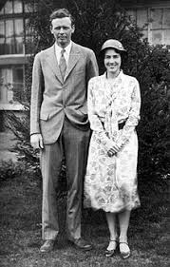
It was through a second-storey window that Charles Lindbergh III, the 20-month-old son of the famed pilot known as "Lucky Lindy," was kidnapped, never to be seen again.
Lindbergh had flown solo across the Atlantic Ocean in 1927. His feat made him one of the most famous people in the world. He met Anne Morrow later that same year; two years later, they were married.
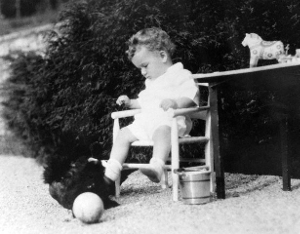
The Lindberghs' first child, Charles Jr., was born in 1930. Little Charles was not yet 2 when he met his ultimate demise, in a set of events that shocked the nation.
The Lindberghs were living at that time in Highfields, a mansion in the small locale of East Amwell, outside Hopewell, N.J. They had built the mansion in 1931 on a secluded part of Sourland Mountain, to escape media attention. Even five years after his aviation feat, Lindbergh was still one of the most recognized people in the U.S.
Little Charles was not in the best of health. Among other maladies, he suffered from a condition that interfered with his bone development. He was routinely given large doses of Vitamin D to stimulate his bone growth.
On the fateful night, March 1, 1932, Betty Gow, the family nurse, had put baby Charles to bed at 7:30 p.m. The room in which Charles was sleeping was on the second floor of the mansion.
About 9:30 p.m., Lindbergh heard a noise; he was in the library, directly below the baby's room. Lindbergh thought that the noise had come from the kitchen, nearby, and so didn't go up to the baby's room.
About 10 p.m, Gow, the nurse, went into the baby's room to check on him and discovered that he was gone and that the window was open. Gow went to see the baby's parents, neither of whom had little Charles.
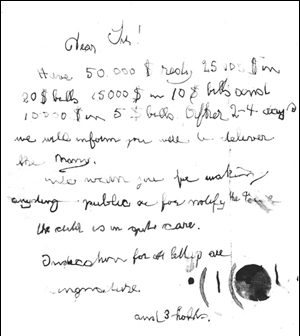
Subsequent examination of the room turned up a note in an envelope on the windowsill. In the envelope was the first of many ransom notes. This one demanded $50,000 for the return of the child.
Charles Lindbergh and the family butler, Olly Whateley, searched outside the house and found the remains of footprints and a ladder, in pieces. Whateley called local police, and Lindbergh called his lawyer and the state police.
The only fingerprints found were those of baby Charles, and police concluded that whoever took him had worn gloves. Even though mud was on the floor of the nursery, experts found no discernible footprints, suggesting that the kidnapper(s) had covered his/their tracks.

The ransom note specified denominations of dollar bills for payment: half in $20 bills, $15,000 in $10 bills, and $10,000 in $5 bills. At the bottom was a visual signature in the form of conjoining circles in the middle of which was a red dot.
The spelling in the ransom note was poor, and Lindbergh and investigators concluded that English was not the first language of the author; further, they speculated for some reason that the writer's first language was German. They also thought that the perpetrator(s) must be connected to organized crime. The kidnapping of the children of rich people was not uncommon at this time.
Multiple layers of law enforcement entered the investigation, including the Bureau of Investigation, the precursor to the FBI –even though at the time, kidnapping was considered a local crime. Attorney General William Mitchell and President Herbert Hoover met to discuss the case, and Mitchell promised full cooperation from the Department of Justice alongside the New Jersey state investigators.
The ransom note said that another note would be forthcoming in two to four days, with instructions on where to leave the money. In the meantime, New Jersey state officials offered a $25,000 reward for the safe return of Baby Charles; Anne and Charles Lindbergh added $50,000 of their own to the reward money. Lindbergh took a leading role in the investigation.
Five days after the kidnapping, on March 6, a new note arrived, postmarked March 4 in Brooklyn and ending with the same visual signature as the first note. This new ransom note raised the asking price to $70,000.
More ransom notes followed, 12 in all; what didn't follow were clues to the baby's whereabouts. At one point, Lindbergh followed up a lead that his son was being held aboard a boat off the coast of Massachusetts; baby Charles was not aboard.
Other people got involved; among these was a well-known retired schoolteacher John Condon, who offered to act as an intermediary and eventually received a few of the ransom notes, along with a toddler's sleeping suit, which Lindbergh identified as his baby son's.
The days dragged on, with no sign of baby Charles's return. On April 2, Condon handed over $50,000 to a man who said his name was John and told Condon that two women were looking after baby Charles.
Still, the Lindberghs did not have their son back. On May 12, a delivery truck driver found baby Charles, in a grove of trees. He had died from a blow to the head. Subsequent examination put the time of death as not long after he was kidnapped.
Investigators pursued many lines of questioning, including one that considered an inside job. One of the suspects was Violet Sharp, who worked in the home of Anne Lindbergh's parents. Sharp was questioned more than once and gave different answers to the same questions. She took her own life rather than be questioned again; police later confirmed that she had been telling the truth when she had said that she was nowhere near the Lindbergh mansion on the night of the kidnapping.
Among the ransom money that Condon paid to the identified man were a number of gold certificates. These certificates were not marked; but each bill had its own serial number, and federal authorities had a list of all serial numbers.
Authorities found that these gold certificates were spent in various neighborhoods of New York City. In late 1934, a bank teller found a certificate with a serial number matching the list from the Lindbergh ransom money. On the bill itself was a car license plate number, which a gas station manager had written on the bill because the man who used it to pay was acting suspicious.
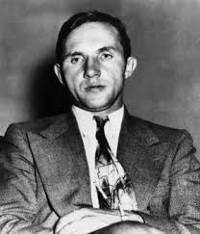
The license plate was on a car belonging to a German immigrant named Richard Hauptmann, who had a criminal record in his homeland. (His first name was Bruno, and he was called Bruno Hauptmann throughout the trial. His preferred first name was actually his middle name, Richard.) Police who arrested him found $14,000 of the ransom money in his garage. A sketch of the man to whom Condon gave the ransom money resembled a photograph of Hauptmann.
During intense questioning, Hauptmann told police that he got the money from a former business partner, Isidor Fisch, who had returned to Germany earlier and died there. Hauptmann denied any involvement in the Lindbergh baby kidnapping.
Police investigation of Hauptmann's home found a notebook with a sketch of a ladder similar to the one found outside baby Charles's window and a piece of wood that matched the wood used to build that ladder. Police also found, written on a closet wall, the address and phone number of John Condon.
On October 8, Hauptmann was indicted for capital murder; a conviction on that charge could result in capital punishment.
The intense interest in the trial, for a variety of reasons –Lindbergh's fame, the death of a baby, the sensational nature of the ransom collection–resulted in the proceedings' being called the "Trial of the Century."
The prosecution, largely depending on the evidence found in Hauptmann's house and garage, presented a case that many observers found compelling. The defense, many observers said, was not so good. Hauptmann could not explain why he had enough money to buy expensive things and send his wife on a trip to Germany when he had not reported for work on the day that the ransom money was paid and had quit his job two days after that, without finding another job. Nor could the defense explain why Fisch was unable to afford basic health care expenses in the last few months of his life, even though Hauptmann had said that Fisch had given him the money that police found in Hauptmann's garage.
What the prosecution didn't have was any witnesses who saw Hauptmann at the scene of the crime or any of Hauptmann's fingerprints or footprints in or outside the baby's room. A handwriting expert testified that Hauptmann's writing matched that of the first ransom note, but Hauptmann's fingerprints were not on the ransom note. The piece of wood taken from Hauptmann's matched the ladder found underneath the baby's window, and tool marks on the ladder matched those usually made by tools that Hauptmann owned; but none of that positively connected Hauptmann with the events on the night of March 1, 1932.
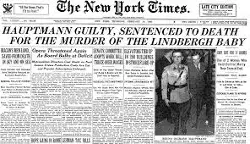
Thus, even though the prosecution's case presented several strong points of evidence, they were circumstantial evidence. Nonetheless, Hauptmann was found guilty of capital murder and sentenced to death. The trial that began on January 2, 1935, ended on February 13.
Hauptmann's attorneys appealed the verdict, to successive levels of courts; all appeals were turned down. He died on April 3, 1936. To the last, he denied any involvement in the crime; at the very last, he refused to confess to having killed baby Charles, even if meant that his sentence would be changed to life in prison.
Congress subsequently passed the Federal Kidnapping Act, making a crime the act of transporting a kidnapping victim across state lines. This act was more widely known as the "Lindbergh Law."
Charles and Anne Lindbergh left Highfields and never returned. They lived in Europe for a time. They had five more children: three sons and two daughters. Charles died in 1974. Anne died in 2001.
In the years since the kidnapping and Hauptmann's execution, many people have advanced differing identities of the kidnapper(s). Some have theorized that a member of the family, perhaps even Lindbergh himself, took the child. Many historians and forensic researchers have found problematic the prosecution's entirely circumstantial case. Hauptmann refused to confess even when offered both a switch to life imprisonment and a payout of $90,000 from a famous news organization. Hauptmann's wife, Anna, continually appealed to New Jersey law enforcement officials to re-examine the evidence; she died in 1994. Other researchers have found troubling the facts that Lindbergh himself led the investigation and had his son cremated immediately after he was discovered. The fact remains that only one person has been convicted of the crime.